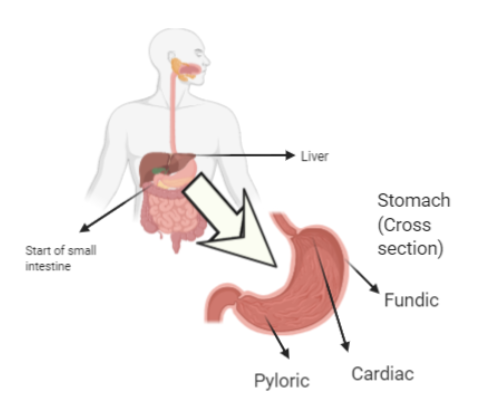
Explain Stomach with diagram.
Answer
474.9k+ views
Hint:
The stomach is a hollow muscular organ in the digestive system. It is one of the major organs of the digestive system altogether. It can expand to hold up to one liter of food. The main function of the stomach is to provide an acidic medium to digest the food material. It acts as the main site of protein digestion.
Complete answer:
The stomach lies between the esophagus of the gut and the duodenum of the small intestine. It is located in the upper left part of the abdomen, just below the lobes of the liver. The upper portion of the stomach lies close to the diagram. This results in the control of breathing concerning the stretching of muscles of the stomach.
Anatomically, the stomach is divided into three major parts. Cardiac, Fundic, and pyloric.
Cardiac – This is the part where food from the esophagus is emptied into the stomach. The stomach receives this content and it undergoes heavy physical and chemical digestive processes.
Fundic – This is the curved part of the upper left side of the stomach, that carries gastric glands known as oxyntic glands. They help in digestion by the acidification of the stomach by producing HCl and some proteolytic enzymes
Pyloric – It is the lower section of the stomach that empties the partially digested food (chyme) into the duodenum.
Apart from these three parts, the rest of the stomach is called the body of the stomach. This is where digestion happens majorly.
The bolus of food from the esophagus will trigger the release of proteases such as pepsin and HCl from the glands (The pH of the stomach during digestion is around 2.0). The stomach has a thick layer of mucus coating to prevent it from being damaged by HCl.

Note: Although most absorption occurs in the intestine, the stomach absorbs quite a lot of metabolites. Amino acids, Medication, Ethanol (from alcoholic beverages) are absorbed in the stomach. Water is also absorbed in the stomach in dehydrated conditions. A peristaltic movement of the muscles will ensure the churning of the food in the stomach. The partially digested food is then released to the intestine.
The stomach is a hollow muscular organ in the digestive system. It is one of the major organs of the digestive system altogether. It can expand to hold up to one liter of food. The main function of the stomach is to provide an acidic medium to digest the food material. It acts as the main site of protein digestion.
Complete answer:
The stomach lies between the esophagus of the gut and the duodenum of the small intestine. It is located in the upper left part of the abdomen, just below the lobes of the liver. The upper portion of the stomach lies close to the diagram. This results in the control of breathing concerning the stretching of muscles of the stomach.
Anatomically, the stomach is divided into three major parts. Cardiac, Fundic, and pyloric.
Cardiac – This is the part where food from the esophagus is emptied into the stomach. The stomach receives this content and it undergoes heavy physical and chemical digestive processes.
Fundic – This is the curved part of the upper left side of the stomach, that carries gastric glands known as oxyntic glands. They help in digestion by the acidification of the stomach by producing HCl and some proteolytic enzymes
Pyloric – It is the lower section of the stomach that empties the partially digested food (chyme) into the duodenum.
Apart from these three parts, the rest of the stomach is called the body of the stomach. This is where digestion happens majorly.
The bolus of food from the esophagus will trigger the release of proteases such as pepsin and HCl from the glands (The pH of the stomach during digestion is around 2.0). The stomach has a thick layer of mucus coating to prevent it from being damaged by HCl.

Note: Although most absorption occurs in the intestine, the stomach absorbs quite a lot of metabolites. Amino acids, Medication, Ethanol (from alcoholic beverages) are absorbed in the stomach. Water is also absorbed in the stomach in dehydrated conditions. A peristaltic movement of the muscles will ensure the churning of the food in the stomach. The partially digested food is then released to the intestine.
Recently Updated Pages
Master Class 11 Accountancy: Engaging Questions & Answers for Success

Express the following as a fraction and simplify a class 7 maths CBSE

The length and width of a rectangle are in ratio of class 7 maths CBSE

The ratio of the income to the expenditure of a family class 7 maths CBSE

How do you write 025 million in scientific notatio class 7 maths CBSE

How do you convert 295 meters per second to kilometers class 7 maths CBSE

Trending doubts
Which are the Top 10 Largest Countries of the World?

Differentiate between homogeneous and heterogeneous class 12 chemistry CBSE

What is a transformer Explain the principle construction class 12 physics CBSE

Draw a labelled sketch of the human eye class 12 physics CBSE

What are the major means of transport Explain each class 12 social science CBSE

What is the Full Form of PVC, PET, HDPE, LDPE, PP and PS ?




